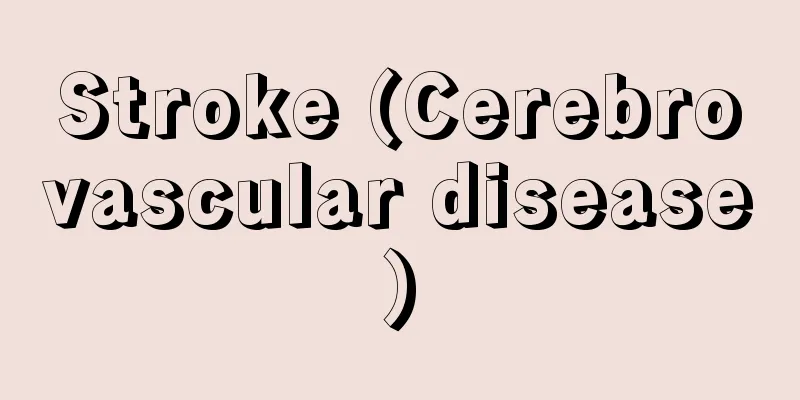Stroke (Cerebrovascular disease)

What is a stroke? The word "stroke" is a general term, not a medical term. The official term is "cerebrovascular disease." This is a word that was introduced from China, but it appears in Japanese books from 760 A.D., which shows that this disease has a long history in Japan. It is also evidence that people had some understanding of the existence of a disease called stroke even before the development of modern medicine. Classification of cerebrovascular disorders As shown in Figure 1, the blood vessels in the brain may be damaged by arteriosclerosis or by blood flowing from other parts of the body ( On the other hand, many small lumps form in the thin blood vessels deep in the brain due to high blood pressure or aging, and when blood pressure rises suddenly, these can burst and enter the brain. We'll explain each of these in more detail later. Although stroke is one of the national diseases in Japan, the number of deaths from stroke is showing a tendency to decrease year by year. However, this is mainly due to the decrease in deaths from cerebral hemorrhage, while the number of deaths from cerebral infarction and subarachnoid hemorrhage has not decreased very much. In fact, while the mortality rate has decreased, the incidence rate has not, so the number of patients actually being treated in hospitals is increasing. A survey conducted in Japan on a certain day showed that of 1.48 million stroke patients who were hospitalized or visited the outpatient clinic that day, approximately 75% had cerebral infarction, 15-20% had cerebral hemorrhage, and 5-10% had subarachnoid hemorrhage. This shows that three-quarters of stroke patients in Japan have cerebral infarction. What is the cause?The biggest causes of stroke are said to be high blood pressure and aging. However, there are many other known causes, which are called risk factors. Of course, risk factors differ slightly depending on whether it is cerebral infarction, cerebral hemorrhage, or subarachnoid hemorrhage. Risk factors for cerebral hemorrhage include high blood pressure, aging, bleeding diathesis (difficulty in blood clotting), arteriosclerosis, etc. The strongest risk factors for subarachnoid hemorrhage are the presence of an aneurysm and high blood pressure. The most common causes of cerebral infarction are various. In addition to high blood pressure and aging, other causes include diabetes, heart disease, dyslipidemia, obesity, smoking, excessive drinking, stress, dehydration, inflammation, etc. Testing and preventionMany risk factors can be identified through simple tests. If these factors are found during a health check or medical examination, early lifestyle changes and treatment can help prevent stroke. Although aging and heredity cannot be cured, properly treating other risk factors that exist at the same time can be quite effective in preventing stroke. MRI scans performed during brain checkups and other similar tests may reveal cerebral infarction (hidden cerebral infarction, etc.) even if the patient is asymptomatic. In some cases, an aneurysm may be discovered before it ruptures. In this case, do not just worry, but consult a specialist doctor (neurologist, brain surgeon, stroke specialist, etc.) as soon as possible. There are various preventive measures. What to do if you notice an illnessIf you feel that you may be having a stroke, even if the symptoms are mild, you should go to a hospital with a specialist as soon as possible. To that end, if you have elderly family members with many risk factors for stroke, it is a good idea to think about which nearby hospital you should take them to in the event of a stroke. Stroke is a terrible disease, but death can be avoided or aftereffects can be minimized by getting the patient to a well-equipped hospital with specialist doctors as soon as possible. Yukito Shinohara "> Figure 1. Various types of stroke Source: Houken “Sixth Edition Family Medicine Encyclopedia” Information about the Sixth Edition Family Medicine Encyclopedia |
脳卒中とは 脳卒中という言葉は一般的な用語であり、医学用語ではありません。正式には脳血管障害といいます。脳卒中の卒は これは中国から渡ってきた言葉ですが、西暦760年の日本の書物にすでに見られますから、この病気は日本でも長い歴史をもっていることがわかります。近代医学が発展する前から、人々は卒中という病気があることをある程度理解していたことの証拠でもあります。 脳血管障害の分類 図1に示すように、脳の血管が動脈硬化や、ほかの部位から流れてきたもの( 一方、脳の深部の細い血管に高血圧や加齢によって小さなこぶがたくさんでき、これが急に血圧が上昇した時などに破裂して脳のなかに そのおのおのについてはあとで詳しく説明します。 脳卒中は日本の国民病のひとつではありますが、その死亡数は年々減る傾向を示しています。しかしそれは主に脳出血による死亡が減っているからで、脳梗塞やくも膜下出血による死亡はあまり減っていません。 むしろ死亡率が下がっているわりには発症率が下がっていないので、実際に病院にかかっている患者さんの数は増えています。 日本におけるある日の調査では、その日に入院中、あるいは外来を訪れた148万人の脳卒中の患者さんのなかで、脳梗塞が約75%、脳出血が15~20%、くも膜下出血が5~10%という結果が出ています。日本で脳卒中で悩む患者さんの4分の3が脳梗塞であることがわかります。 原因は何か脳卒中を起こす最大の原因は、高血圧と加齢だといわれています。しかしそのほかにもたくさんの原因が知られており、それらは危険因子と呼ばれています。もちろん、脳梗塞、脳出血、くも膜下出血かによって危険因子は多少違います。 脳出血は高血圧と加齢に加えて、出血性素因(血が固まりにくいこと)や動脈硬化などが危険因子になります。くも膜下出血は動脈瘤の存在と高血圧が最も強い危険因子です。 いちばん数の多い脳梗塞の原因はさまざまです。高血圧、加齢のほかに糖尿病、心臓病、脂質異常症、肥満、喫煙、多量飲酒、ストレス、脱水、炎症、 検査と予防危険因子の多くは簡単な検査でわかります。健康診断や人間ドックでこれらの因子が見つかれば、早めに生活習慣の改善や治療をすることが脳卒中の予防につながります。加齢や遺伝は治療できませんが、同時に存在する他の危険因子をしっかり治療すれば、脳卒中の予防に十分役立ちます。 脳ドックなどで行うMRI検査で偶然、無症状ではあっても、脳梗塞(かくれ脳梗塞とか また、破裂する前の動脈瘤が見つかることもあります。この時は、ただ心配するだけではなく、早急に専門の医師(神経内科医、脳外科医、脳卒中専門医など)に相談してください。いろいろな予防法があります。 病気に気づいたらどうする軽い症状でも脳卒中らしいと感じたら、1分でも1秒でも早く専門医のいる病院へ行くことです。そのためには、家族に脳卒中の危険因子を多くもつ高齢者がいる場合は、万一の場合、近くのどこの病院に運べばよいかを普段から考えておくとよいと思います。 脳卒中は恐ろしい病気ですが、施設の整った専門医のいる病院に1分でも早く連れていくことで、死を免れたり後遺症を少なくすることができます。 篠原 幸人 "> 図1 脳卒中のいろいろ 出典 法研「六訂版 家庭医学大全科」六訂版 家庭医学大全科について 情報 |
>>: A compilation of agricultural and sangyo farming
Recommend
Asparagus myriocladus (English spelling)
… [Munemin Yanagi]. … *Some of the terms mentione...
Manaslu [Mountain] - Manaslu
A high peak in the Himalayas, northwest of Kathman...
Basic niche - Kihonnichi
...Therefore, when understanding an ecological ni...
Johannsen, Wilhelm Ludvig
Born: February 3, 1857 in Copenhagen Died: Novembe...
Soffici - Soffici (English spelling) Ardengo Soffici
Italian critic and painter. During his stay in Pa...
Joch
…overhangA rock that juts out like a eaves. It is...
Akaze
[ Decapterus muroadsi ]. A marine fish of the genu...
Angina pain
…Of these, pain originating from the heart is dis...
Kakiuchi style village - Kaito toshikisonraku
…Following German settlement geography, in 1913 T...
Standing wave
...In addition, there are special tires such as s...
《Ambarwaria》 - Ambarwaria
...This collection of poems, with its bright inte...
Hungarian Basin
A basin that spreads across the middle reaches of ...
Matarajin - Matarajin
[1] A Buddhist term. The guardian deity of the Jyo...
Nakamuraza
The name of a kabuki theater. It is the oldest of ...
Anrakuji Temple (Saitama) - Anrakuji Temple
...Housing development is also taking place in th...






![August Thyssen-Hütte [company] - August Thyssen-Hütte](/upload/images/67cf192ed4156.webp)
![Iwakura [Hot Spring] - Iwakura](/upload/images/67cf758d2f2af.webp)

